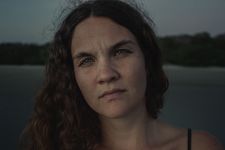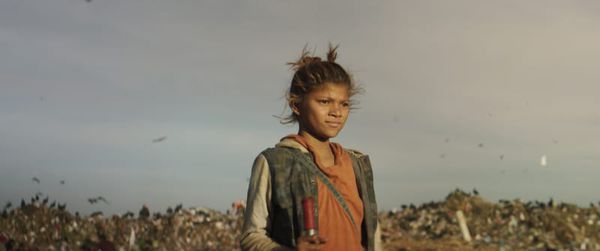Speaking to Baumeister over Zoom from Toronto, where the film screened ahead of making its European debut at San Sebastian Film Festival, I asked her how she felt about the old warning about never working with children or animals since she does both during the course of this shoot - especially given the challenging settings, like La Chureca.
 |
| Director Laura Baumeister says shooting her film in Nicaragua was 'one the virtues and one of the biggest challenges' |
Nicaragua isn’t a common setting for films and the conditions that some of the scenes are shot in, such as the landfill, presented challenges but Baumeister says that preparation was the key to the success of the shoot.
“It was like a moving table with glasses of water on top and on top of that it was shaking all the time,” she explains. “We assumed the shakiness and tried to perform a dance. We talked a lot about this during the production design, during the financing, during the pre-production. What I knew is that if you're going to work in these types of conditions, you have to put it on the table as clearly as possible. So you really prepare yourself and your crew and your collaborators. By doing that, it's not that it's less challenging, but it's less mind-blowing because you are already prepped. We did immerse ourselves, we went for two years off and on to the place - we did the casting from there and built a relationship with the community.”
Baumeister says that La Chureca was one of the starting points for the film, but there were also thematic elements she wanted to include.
She adds: “I already had worked before in my short films on the mother-daughter relationship, the frontiers between animals and humanity or the savage, the untamed and civilised. But when the project of the feature film was moving forward, I thought let's bring these already explored topics to this place, La Chureca, that I had encountered 15 years before.”
Those ideas of contrast, between the wild and the tamed, beauty and ugliness, destruction and repurposing objects run right through the film. Additionally, there’s a contrast between the difficult everyday reality of life for Maria and the fantastical world she escapes to in dreams.
Perhaps unexpectedly, the recycling plant where Maria’s mum finds herself forced to leave her is, despite being a tough environment, something of a haven for the little girl and the other children that she meets there.
Explaining why she gave the place a more benevolent vibe, Baumeister says: “I truly believed that the character deserved a breather. And, it could sound unexpected, but even in the worst conditions, say being in jail, another person could approach you and give you their bread of the day - that’s a breather and that is an expression of solidarity. And that is a tender expression that coexists within the brutality.
“So I felt that the character really needed a breather. And, I also thought that the audience could need a breather. I was also thinking about how kids relate. Okay, kids can fight, so we're going to see them fight, of course. But they can also sing, they can also collaborate, they can also share their tools, they can also help you with your most important need, which is to find your mother. It also came because of really knowing these places. Then you realise there's way more light than you preconceive from a place of privilege.”
When it came to working with the children, Baumeister says she had a strong collaboration with an acting coach and her casting director.
She adds: “I had a script and we rehearsed. We did different types of approaches, from improvising to really rehearsing the actual scenes, and getting the kids to remember the lines through elements through interactions. Kids have such a fresh brain, it's amazing, they remember everything.”
Preparation is evidently key for Baumeister who says she always does a “massive amount” of research “of pictures, paintings, drawings, everything that can make us like pre-visualise the atmosphere.
Baumeister says, in terms of images they wanted it to be “like a punch in the plexor, and then to rub it better”. She adds: “We felt that the poetry and the beauty are a disarming thing. If all the time you’re just punching, punching, punching, I think you get rejected. But it was important to punch because that is true to the story, we couldn't just beautify everything. We talked a lot about Caravaggio, for example, in the night, where the kids are singing with just some hints of light.”
Baumeister, who studied filmmaking in Mexico, says that making Daughter Of Rage in Nicaragua “as one the virtues and one of the biggest challenges”.
She adds: “Again, it's contrast. All this film was caught by contrast. Nicaragua was really challenging, as you know, there’s no industry, no bank of images that we could talk about - maybe just during the war during the 80s, that was the biggest reference that we had. There was a sense of responsibility, assuming that it was a long shot, and maybe could be another five years for another long shot. So if, if we were lucky, what memories do we want to bring? What identity do we want to talk about? So really using the space in the frame with that conscience.”
She says that to shoot in Nicaragua meant merging local creators with talen from Costa Rica, Guatemala, Mexico and, in the case of the cinematographer Teresa Kuhn, as far afield as Germany. Looking forward, Baumeister says the immediate future holds two projects in store for her and although neither will be shot in Nicaragua, one is inspired by it.
“They are both feature films,” she adds “One is a genre movie, it’s a post-horror. Basically, it's focused on how evilness has been related to the woman's body. It has a very high feminist approach and it involves a revenge story. The other one is a love story in an animalistic setting. Let's say, I feel the need to give a love story after doing Daughter Of Rage.
Daughter Of Rage screens at San Sebastian Film Festival this week, where it is competing for New Directors accolade and the Spanish Cooperation Award
























